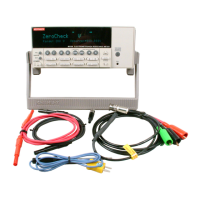Model 6517A Getting Started Manual Remote Operation 3-9
Long and short form commands
Every SCPI command has a short form, and most also have a long form. The notation used
in documentation shows the short form in upper case, with the remainder of the name,
which creates the long form, shown in lower case. There are no intermediate forms of the
command name. You must send the exact short or long form. However, you do not have to
use the mixed capitalization. The Model 6517A accepts commands in any combination of
upper and lower case. For example, all of the following are valid forms of the
SENSe1:VOLTage[:DC]:REFerence command:
sense1:voltage[:dc]:reference:state
sens1:volt[:dc]:ref:stat
SENS1:volt[:DC]:rEFErENCe:STat
Query commands
With few exceptions, every SCPI command has a corresponding query. A command sets a
control point in the instrument; a query determines the present setting of the control point.
The query is simply the command name with a “?” attached.
Some commands are actions rather than control point settings. These commands have no
query form. For example,
SENSe1:VOLTage[:DC]:REFerence:ACQuire
is an action command, not a setting, and so has no query form.
There are some queries that have no corresponding command. For example,
SENSe1:DATA? causes the instrument to return the latest reading. Of course, there is no
corresponding command to send a reading value to the instrument.
Default nodes
SCPI uses the concept of default nodes. Consider the example command tree shown
previously in Figure 3-2. What is within square brackets is not necessary to send to the
instrument, but the instrument will accept it if you send it. Consider the :UPPer
command, which sets the measurement range. To set the Model 6517A to measure
15VDC, any of the following commands works:
SENSe1:VOLTage[:DC]:RANGe:UPPer 15
SENSe:VOLTage[:DC]:RANGe:UPPer 15
SENSe1:VOLTage[:DC]:RANGe 15
VOLTage[:DC]:RANGe:UPPer 15
VOLTage[:DC]:RANGe 15
These are shown in long form, but short forms could also be used.

